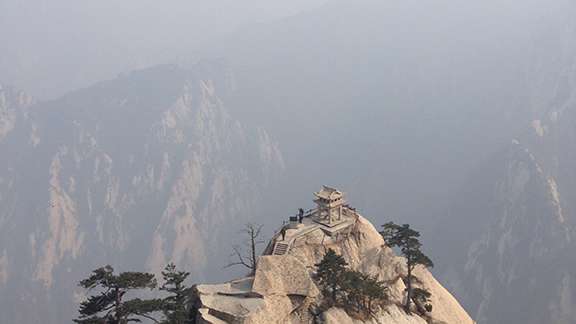Pollution stifles wind, squelches rain

Like a high stakes match of rock-paper-scissors, summertime pollution trumps both wind and precipitation in the valley air near Mt. Hua. Scientists at Pacific Northwest National Laboratory found that human-caused air pollution suppresses up to 40% of the precipitation over Mt. Hua during one month in the summer.
Normally, precipitation in mountainous areas is strongly influenced by air coming from up-wind. In China, this air often occurs in a low elevation plain containing severe air pollution. The researchers found that a major force responsible for the decline of mountain precipitation is the heavy pollution that interacts with sunlight energy (solar radiation) to weaken the valley breeze and reduce surface moisture.
"As a result, the usual transport of water vapor from the valley to the mountain is significantly reduced," said the study's lead climate modeler Dr. Jiwen Fan, a PNNL atmospheric scientist. "This causes cascading effects that suppress convection—the process that forms stormy rain clouds—and precipitation over the mountain."
Precipitation over mountain ranges is especially important since it provides a major source of water supply for agricultural, domestic, and industrial use. Significant reduction in precipitation in the past decades has been documented over many mountain ranges such as those in central and eastern China. A major concern is how the severe pollution in the populated plains affects the downwind mountainous precipitation. Increased air pollution in those regions is the likely culprit, because the tiny aerosol particles are linked with reduced precipitation.
Up until now, there have been no rigorous studies that quantify the mechanisms responsible for the precipitation reduction. The PNNL research team discovered a major mechanism clearly showing how the absorbing aerosol particles in the plain contribute to the reduced precipitation over the mountain. The study and the finding are not only important to improve understanding of the weather and climate impacts of the severe pollution in China, but also useful to inform policies to address emissions from industrial and automotive sources and air quality.
The research team led by PNNL employed an improved Weather Research and Forecasting (WRF) model with online coupled chemistry (WRF-Chem), and conducted one-month summer convection simulations at the convection-permitting scale using current emission data. To explore aerosol impacts and the specific mechanisms in this study, the researchers carried out sensitivity simulations by reducing the emissions to the level before the Chinese economic boom and by turning on and off aerosol-radiative interactions. They gathered observational data in surface radiation fluxes, aerosol optical depth, and precipitation to evaluate the model simulations with current emission data.
The PNNL team is exploring aerosol particle impacts on the mountainous regions in the Western United States using new field data collected during the ARM Climate Research Facility's ACAPEX field campaign.
More information: Yan Yang et al. Mechanisms Contributing to Suppressed Precipitation in Mt. Hua of Central China. Part I: Mountain Valley Circulation, Journal of the Atmospheric Sciences (2016). DOI: 10.1175/JAS-D-15-0233.1
Provided by Pacific Northwest National Laboratory



















